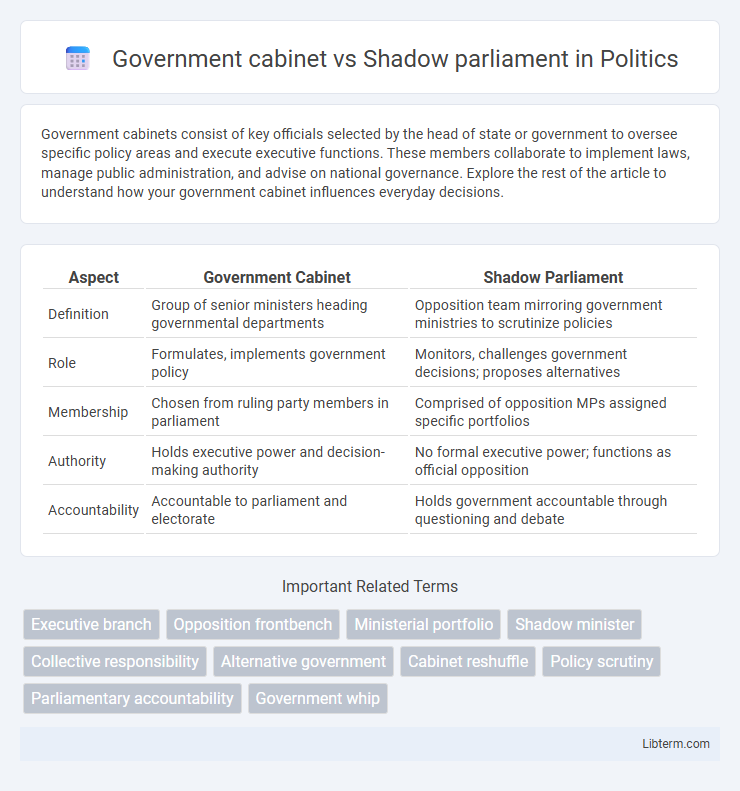Government cabinets consist of key officials selected by the head of state or government to oversee specific policy areas and execute executive functions. These members collaborate to implement laws, manage public administration, and advise on national governance. Explore the rest of the article to understand how your government cabinet influences everyday decisions.
Table of Comparison
| Aspect | Government Cabinet | Shadow Parliament |
|---|---|---|
| Definition | Group of senior ministers heading governmental departments | Opposition team mirroring government ministries to scrutinize policies |
| Role | Formulates, implements government policy | Monitors, challenges government decisions; proposes alternatives |
| Membership | Chosen from ruling party members in parliament | Comprised of opposition MPs assigned specific portfolios |
| Authority | Holds executive power and decision-making authority | No formal executive power; functions as official opposition |
| Accountability | Accountable to parliament and electorate | Holds government accountable through questioning and debate |
Understanding Government Cabinets: Definition and Role
A government cabinet consists of senior officials, typically ministers, appointed by the head of state or government to oversee various departments and implement public policies. It functions as the executive branch, making decisions on legislation, administration, and national governance. The cabinet's role includes coordinating government operations, advising the leader, and shaping the political agenda within the formal government framework.
What is a Shadow Parliament?
A Shadow Parliament consists of opposition members who scrutinize and challenge the policies and actions of the Government cabinet, acting as a government-in-waiting. Each Shadow Minister is assigned to a specific cabinet portfolio, providing alternative policies and holding the Government accountable. This parallel structure ensures democratic oversight and prepares the opposition for potential governance.
Historical Origins of Cabinets and Shadow Parliaments
Government cabinets originated in the early modern period as executive bodies advising sovereigns, evolving from monarchic councils to structured entities centralizing decision-making power in parliamentary systems. Shadow parliaments emerged in the 20th century within Westminster-style democracies as institutionalized opposition groups mirroring government cabinets to provide alternative policies and maintain parliamentary accountability. These parallel structures reflect the development of representative governance, with cabinets gaining authority through formal appointments and shadow parliaments strengthening democratic checks and balances through organized critique.
Key Functions of a Government Cabinet
The Government Cabinet primarily directs national policy, formulates laws, and oversees the execution of government programs through various ministries and departments. It serves as the central decision-making body, ensuring coordinated implementation of economic, social, and foreign policies. In contrast, the Shadow Parliament's role is to scrutinize government actions, hold ministers accountable, and propose alternative policies.
Responsibilities and Powers of a Shadow Cabinet
The government cabinet holds executive authority, implementing policies, managing public administration, and making national decisions, while the shadow cabinet's primary role is to scrutinize government actions, develop alternative policies, and hold ministers accountable. Shadow cabinet members mirror official cabinet positions, providing expertise and readiness to assume power if the opposition wins an election. Their responsibilities include questioning government proposals, offering policy critiques, and representing alternative leadership to ensure democratic checks and balances.
Differences Between Cabinet and Shadow Parliament Structures
The Government cabinet consists of officially appointed ministers responsible for executive decision-making and policy implementation, while the Shadow Parliament is composed of opposition members assigned to scrutinize and challenge the cabinet's actions. Cabinet members hold formal governmental authority and lead specific ministries, whereas Shadow Parliament members serve as spokespersons on corresponding issues without executive power. Structurally, the cabinet operates within the ruling party or coalition, whereas the Shadow Parliament forms part of the opposition aiming to offer alternative governance proposals.
Interaction and Accountability: Cabinet vs. Shadow Parliament
The Government Cabinet directly implements policies and is accountable to the legislature through formal mechanisms such as parliamentary questioning and votes of confidence. The Shadow Parliament, composed of opposition members, scrutinizes government actions by debating policies, proposing alternatives, and holding the Cabinet to account in public forums. Interaction between the two is characterized by structured oversight, where the Shadow Parliament ensures transparency and responsiveness within the Cabinet's decision-making process.
Impact on Policy Development and Legislation
The Government Cabinet holds the authority to directly formulate and implement policy, accelerating legislative processes through executive decision-making and coordinated ministerial actions. In contrast, the Shadow Parliament plays a critical role in scrutinizing government proposals and suggesting alternative policies, thereby shaping legislation indirectly by promoting accountability and fostering public debate. This dynamic interaction between the Cabinet's proactive governance and the Shadow Parliament's oversight enhances the overall quality and responsiveness of legislation within a democratic system.
Significance in Democratic Governance
The Government cabinet holds executive authority, implementing policies and managing public administration, which is essential for effective governance and policy execution in a democracy. The Shadow Parliament, comprising opposition members, plays a crucial role in accountability by scrutinizing the government's decisions and presenting alternative policies, enhancing transparency and democratic checks and balances. This dynamic fosters a competitive political environment, ensuring responsiveness to citizens' needs and preventing the concentration of power.
Case Studies: Government Cabinets and Shadow Parliaments Worldwide
Government cabinets, such as the UK's Cabinet of Ministers and Canada's Privy Council, hold executive power, making policy decisions and implementing laws within parliamentary democracies. Shadow parliaments, exemplified by the UK's Shadow Cabinet and Australia's Opposition Frontbench, provide an organized opposition that scrutinizes government actions and presents alternative policies. Case studies from India and South Africa reveal how shadow cabinets strengthen democratic accountability by fostering robust debates and preparing opposition parties for governance.
Government cabinet Infographic

 libterm.com
libterm.com